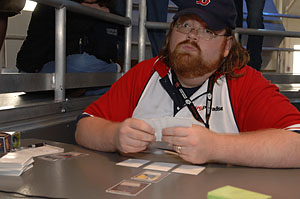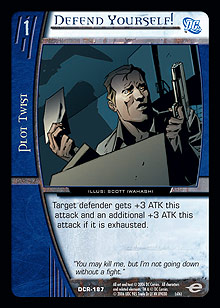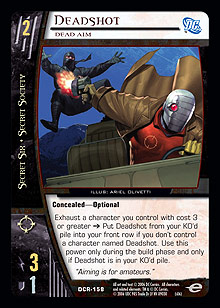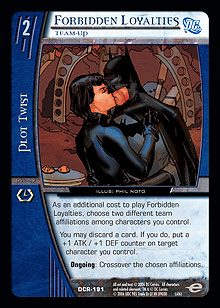
 Welcome back to my article series taking a look at the different deckbuilding approaches of some of Australia’s top Sealed players. This installment follows immediately from last week’s article about Luke Bartter’s Infinite Crisis Sealed Pack deck. This week, I’ll give you an inside look at Bartter’s opponent that night, Scott Hunstad. Scott has already been featured in one of the articles I did on drafting The X-Men. Fortunately, Scott is no shrinking violet, and he was quite welcoming of the attention!
Welcome back to my article series taking a look at the different deckbuilding approaches of some of Australia’s top Sealed players. This installment follows immediately from last week’s article about Luke Bartter’s Infinite Crisis Sealed Pack deck. This week, I’ll give you an inside look at Bartter’s opponent that night, Scott Hunstad. Scott has already been featured in one of the articles I did on drafting The X-Men. Fortunately, Scott is no shrinking violet, and he was quite welcoming of the attention!
This is the pool Scott opened:
Atom Smasher, Al Rothstein
Jakeem Williams, JJ Thunder
Terry Sloane ◊ Mr. Terrific, Golden Age Gold Medalist
Michael Holt ◊ Mr. Terrific, Renaissance Man
Ted Grant ◊ Wildcat, Golden Age Pugilist
Charles McNider ◊ Dr. Mid-Nite, Golden Age Academic
Superman, Earth 2
The Phantom Stranger, Wandering Hero
Taking Up the Mantle
Brothers in Arms
Detective Chimp, Bobo T. Chimpanzee
Nightmaster, Jim Rook
2 Manitou Dawn, Spirit Shaman
Dr. Occult, Richard Occult
Witchfire, Rebecca Carstairs
2 Blue Devil, Big Blue
Zatanna, Showstopper
Dr. Fate, Hector Hall
Mystical Binding, Magic
Aspiring Pawn, Army
Sarge Steel, Knight
Ahmed Samsarra, White King
Arthur Kendrick, Knight
Graziella Reza, Knight
Elimination Protocol ◊ OMAC Robot, Army
Annihilation Protocol ◊ OMAC Robot, Army
Sasha Bordeaux, Autonomous Prototype
Target Acquired
Knights’ Gambit
Pawn of the Black King
Rook Control
Checkmate Armory
Cheetah, Feral Feline
Weather Wizard, Mark Mardon
Zazzala ◊ Queen Bee, Mistress of the Hive
Dr. Light, Furious Flashpoint
The Calculator, Evil Oracle
Sinestro, Villain Reborn
Alexander Luthor, Insidious Impostor
Fatality, Flawless Victory
Mr. Freeze, Brutal Blizzard
Alexander Luthor, Diabolical Double
The Calculator, Crime Broker
Coercion, Team-Up
No Mercy
Baddest of the Bad
Amadeus Arkham, Architect of Insanity
Fiddler, Isaac Bowin
Deadshot, Dead Aim
Ragdoll, Resilient Rogue
Mordru, Dark Lord
Secret Six Victorious
Return of Donna Troy
A Moment of Crisis
Burning Gaze
Deflection
2 Defend Yourself!
Forbidden Loyalties, Team-Up
Multiverse Power Battery
Return Fire!
Justice United, Team-Up
Dr. Fate’s Tower
Leslie Thompkins’s Clinic
Thanagar
Laser Watch
Cloak of Nabu
Amulet of Nabu
Scott started by separating the cards into characters, plot twists, equipment, and locations (seems like a common theme). He doesn’t think there is one best method of further separating the cards, but he notes that there are so many cards in Sealed Pack that you need to have some plan for organizing them from the outset. Scott doesn’t really look at the cards until separated, but like Luke, he had a keen eye for rares, particularly the big sellers.
Scott then went on to separate his cards even more, sorting team-stamped non-character cards by affiliation. He hoped to see strong Villains United and/or Checkmate representation, as he thinks those are the best teams. According to Scott, JSA is too thin for Sealed; it has good characters but too many holes in the curve. He considers Shadowpact something of a quirky team, having a lot of filler but not really much gas overall.
 Scott expressed some dismay at the lack of good Checkmate locations before noting that he did have several Team-Ups, which are something of the lifeblood of Vs. System Sealed. Team-Ups can quite easily save otherwise mediocre pools when opened in sufficiency. Scott was impressed with double Defend Yourself!, which he thinks is very good. Conversely, he didn’t have anything good to say about Burning Gaze, even though he admits that it is playable. At this stage of building his Sealed decks, Scott doesn’t really have a set curve in mind. He likes to look at his best cards or teams and go from there. Scott didn’t have firm opinions on the number of 1-drops that should make his deck, for example.
Scott expressed some dismay at the lack of good Checkmate locations before noting that he did have several Team-Ups, which are something of the lifeblood of Vs. System Sealed. Team-Ups can quite easily save otherwise mediocre pools when opened in sufficiency. Scott was impressed with double Defend Yourself!, which he thinks is very good. Conversely, he didn’t have anything good to say about Burning Gaze, even though he admits that it is playable. At this stage of building his Sealed decks, Scott doesn’t really have a set curve in mind. He likes to look at his best cards or teams and go from there. Scott didn’t have firm opinions on the number of 1-drops that should make his deck, for example.
Looking at his JSA, Scott had mixed emotions. He thought his original assessment of the team remained accurate—with the team lacking a good curve—but like Luke, he was impressed by the twin Mr. Terrifics. Terry Sloane ◊ Mr. Terrific, Golden Age Gold Medalist and Michael Holt ◊ Mr. Terrific, Renaissance Man could potentially provide the foundation for a fearsome off-curve deck. On top of that, Scott only had good things to say about Atom Smasher, Al Rothstein, which he believes is one of the premier turn 1 plays in the format.
Looking over Shadowpact, Scott felt that team offered more characters who filled a general curve. Detective Chimp, Bobo T. Chimpanzee is very, very good. Witchfire, Rebecca Carstairs and double Blue Devil, Big Blue seemed okay. Dr. Occult, Richard Occult can be good. Scott mentioned that he likes Zatanna, Showstopper, particularly if his deck is trying to win on turn 6. If he’s looking to win on turn 6, Zatanna could be used to draw a few extra cards to fuel a rampage, and defending on turn 6 is never bad with 13 DEF. Still, there just wasn’t much of a deck there.
Fortunately, Scott had extremely good Villains United characters. Fatality, Flawless Victory, Sinestro, Villain Reborn, and Alexander Luthor, Insidious Impostor could all be superstars at their slot. Scott believes Alexander Luthor, Diabolical Double, Mr. Freeze, Brutal Blizzard, and The Calculator, Evil Oracle could be the best characters in the format at their respective drops. On top of all of this, Scott had Cheetah, Feral Feline, Baddest of the Bad, No Mercy, and Coercion to ensure he didn’t have to look elsewhere for the bulk of his deck.
Still, Scott had to feel a little exasperated when his Checkmate pool turned out to be decidedly average. Ahmed Samsarra, White King is obviously very powerful, but he is restricted by loyalty—reveal. Annihilation Protocol ◊ OMAC Robot, Army is quite good, and it could definitely be a splash possibility. Sarge Steel, Knight is definitely good, but the rest of the team seemed to be 4 ATK / 5 DEF, which Scott and I both believe to be weak. A quick look at his possible ATK pumps showed that this weakness could not be overcome, so Checkmate was unlikely to be a support team to Villains United.
 Of his non-featured-team cards, Scott liked Ragdoll, Resilient Rogue, though he couldn’t really see himself wanting it that much, as his Villains United 4-drops were so good. Scott thinks Deadshot, Dead Aim is awesome, and he would include it in any deck. Scott really likes free characters, and the concealed potential of this card would allow him to return it (and hide it) whenever he wanted.
Of his non-featured-team cards, Scott liked Ragdoll, Resilient Rogue, though he couldn’t really see himself wanting it that much, as his Villains United 4-drops were so good. Scott thinks Deadshot, Dead Aim is awesome, and he would include it in any deck. Scott really likes free characters, and the concealed potential of this card would allow him to return it (and hide it) whenever he wanted.
Realizing that his options were essentially limited to what Villains United could cough up and the other teams could support, he started with the Villains. This was his initial skeleton of the deck:
Cheetah, Feral Feline
Weather Wizard, Mark Mardon
Deadshot, Dead Aim
Zazzala ◊ Queen Bee, Mistress of the Hive
The Calculator, Evil Oracle
Fatality, Flawless Victory
Alexander Luthor, Insidious Impostor
Sinestro, Villain Reborn
Mr. Freeze, Brutal Blizzard
Alexander Luthor, Diabolical Double
The Calculator, Crime Broker
At this stage, Scott wasn’t happy with what he had to work with. He thought that he would need all the ATK pumps he could get from characters, as he had almost no pumps in his non-character cards (only Laser Watch and Burning Gaze). In this vein, Scott put both Terry Sloane ◊ Mr. Terrific, Golden Age Gold Medalist and Michael Holt ◊ Mr. Terrific, Renaissance Man in his deck with the intention of building something of a short curve. He explained that his options were so poor on the curve that this was really all he would be able to get out of this deck. He would need to hit the ground running, playing a character on the first turn to try to out-tempo the better decks he would theoretically face in a real tournament.
According to Scott, it’s very important that you’re able to assess what is a good pool and what is a bad one in Sealed Pack play. When your options are limited, you need to push the envelope more, taking more risks to try to beat the best decks. When your pool is decent—like Luke’s was last week—you are much better off building a consistent deck that is able to take advantage of its general superiority to the majority of other decks. Scott said that this sort of evaluation is not really possible until you have seen several Sealed Pack pools in a particular format.
With something of an off-curve plan firmly in mind, Scott was happy to add Jakeem Williams, JJ Thunder to his deck. This would give him another search card to go with Baddest of the Bad, meaning he could be looser with some parts of his curve. Unfortunately, Scott isn’t a fan of Manitou Dawn, Spirit Shaman, so he had only three 2-drops he was considering. This is really bad news for an off-curve deck. Scott decided to rely on his 1-drops to fill the hole, because he thinks that a 1-drop is still able to trade with a 2-drop at least half the time.
To clean up the edges, Scott decided to add Ragdoll, Resilient Rogue, as he was likely to be playing more than one 4-drop per game due to the nature of his curve. Scott went down to three Team-Ups—cutting Justice United—and found Brothers in Arms as an extra pump to add to the mix. Finally, Scott considered playing The Phantom Stranger, Wandering Hero as a potential pump, showing how much he was clutching at straws in building this deck. Eventually, he decided to leave it out.
Here’s Scott’s final list:
Characters
Atom Smasher, Al Rothstein
Terry Sloane ◊ Mr. Terrific, Golden Age Gold Medalist
Amadeus Arkham, Architect of Insanity
Jakeem Williams, JJ Thunder
Cheetah, Feral Feline
Deadshot, Dead Aim
Sarge Steel, Knight
Weather Wizard, Mark Mardon
Zazzala ◊ Queen Bee, Mistress of the Hive
The Calculator, Evil Oracle
Ted Grant ◊ Wildcat, Golden Age Pugilist
Michael Holt ◊ Mr. Terrific, Renaissance Man
Fatality, Flawless Victory
Alexander Luthor, Insidious Impostor
Sinestro, Villain Reborn
Ragdoll, Resilient Rogue
Mr. Freeze, Brutal Blizzard
Annihilation Protocol ◊ OMAC Robot, Army
Alexander Luthor, Diabolical Double
The Calculator, Crime Broker
Plot Twists
Coercion
No Mercy
Forbidden Loyalties, Team-Up
2 Defend Yourself!
Brothers in Arms
Deflection
Baddest of the Bad
Burning Gaze
Locations
Thanagar
Equipment
Laser Watch
 In Scott’s estimation, Atom Smasher, Al Rothstein is in the running for not only the best turn 1 play, but also one of the best 1-drops ever (particularly in combination with the Mr. Terrifics). Being of such low cost, he can really save a lot of endurance in the late game. As an aside, Scott says not to attack with him until he is at least 4 ATK. Terry Sloane ◊ Mr. Terrific, Golden Age Gold Medalist goes a long way, and he is probably a first pick in any off-curve deck given that his effect is not team-stamped. Since Scott was playing off-curve, this guy enabled him to maintain characters on off-initiative turns as well. Scott thought Amadeus Arkham, Architect of Insanity wasn’t as strong; one needs a crazy good location like Brother Eye to play him as anything but filler. Jakeem Williams, JJ Thunder was also disappointing for Scott, never being effective in combat or having the team affiliation to look for the appropriate late-game cards. Cheetah, Feral Feline seemed good, especially in combination with Weather Wizard, Mark Mardon and Alexander Luthor, Diabolical Double for big pumps. Additionally, she was just good at smoothing out draws with the bounce effects.
In Scott’s estimation, Atom Smasher, Al Rothstein is in the running for not only the best turn 1 play, but also one of the best 1-drops ever (particularly in combination with the Mr. Terrifics). Being of such low cost, he can really save a lot of endurance in the late game. As an aside, Scott says not to attack with him until he is at least 4 ATK. Terry Sloane ◊ Mr. Terrific, Golden Age Gold Medalist goes a long way, and he is probably a first pick in any off-curve deck given that his effect is not team-stamped. Since Scott was playing off-curve, this guy enabled him to maintain characters on off-initiative turns as well. Scott thought Amadeus Arkham, Architect of Insanity wasn’t as strong; one needs a crazy good location like Brother Eye to play him as anything but filler. Jakeem Williams, JJ Thunder was also disappointing for Scott, never being effective in combat or having the team affiliation to look for the appropriate late-game cards. Cheetah, Feral Feline seemed good, especially in combination with Weather Wizard, Mark Mardon and Alexander Luthor, Diabolical Double for big pumps. Additionally, she was just good at smoothing out draws with the bounce effects.
Sarge Steel, Knight didn’t turn up for Scott often enough for him to make a decent assessment. Weather Wizard, Mark Mardon is fine as a 2 ATK / 3 DEF character, as the effect is good enough to play regardless, and people often forget the vengeance trigger. Deadshot, Dead Aim was a card Scott particularly liked, but due to the many concealed characters in these games, being able to use him as a free attack on a 2- or 3-drop didn’t happen as much as he would have liked. Scott had no regrets about not playing Manitou Dawn, Spirit Shaman, as without ATK pumps, she was never going anywhere.
Zazzala ◊ Queen Bee, Mistress of the Hive wasn’t expected to serve as much more than filler, and her ability never really burns for more than 2. Concealed is good for keeping guys, though. Scott says The Calculator, Evil Oracle is insanely good, especially in combination with a deck that can hit a 1-drop. Ted Grant ◊ Wildcat, Golden Age Pugilist is fantastic in short-curve decks, always going up the curve. Under-dropping is never bad with this guy around. Being able to play powerful 1-drops on later turns should not be underrated. Michael Holt ◊ Mr. Terrific, Renaissance Man has been discussed at length. Needing everyone to be JSA can be tough, but overall, is there anything bad to say?
Fatality, Flawless Victory was surprisingly poor for Scott, taking out some of his own guys at times! She’s probably more a Constructed card than a Sealed or Draft card. Alexander Luthor, Insidious Impostor seems good, but with Scott’s only 6-drop being of the same name, he didn’t really want to play him that often. Scott admitted that when he did play him he was good, but he was clunky in his deck. For Sinestro, Villain Reborn, Scott couldn’t do much more than gush. Having 8 ATK, flight, and a hugely relevant ability is pretty good. Sinestro has to be attacked last in case you have defensive pumps, so he is often extremely effective. Ragdoll, Resilient Rogue wasn’t more than filler in this deck, but he’s good enough that he wasn’t out of place.
Scott was adamant that Mr. Freeze, Brutal Blizzard was the best character in the deck. Having him stunned is good, having him not stunned is good, and 9 ATK / 10 DEF seems to be very annoying in combat. Again, what hasn’t been said before here? Annihilation Protocol ◊ OMAC Robot, Army attacks for 10, and that’s all that matters in Scott’s mind; Scott thinks the ability is not as relevant as many people believe—but it is still a 10 ATK with flight.
Scott thought Alexander Luthor, Diabolical Double was the second-best card in the deck. Having 14 DEF is ridiculous on a 6-drop, and drawing cards is never really bad (and goes nicely with the next card). The Calculator, Crime Broker is average by Scott’s estimation, as he didn’t really suit the deck he was playing. He may be good because he can swing back for a lot of endurance loss when your opponent has odds, but he still requires a pump to hit 7-drops, which can be rough.
 Forbidden Loyalties, Team-Up was quoted as being the best Team-Up there is as an offensive and defensive trick, and Coercion was never really going to be bad with Villains United as the major team. No Mercy was only used by Scott once (in response to Revitalize), but Scott pointed to Luke’s 3-drops being concealed often enough that this card wasn’t usually relevant. Defend Yourself! was excellent for Scott, allowing his many 1-drops to take out bigger characters. For his type of deck, this was invaluable. Scott really liked Brothers in Arms, thinking it highly underrated. It is much better on defense, but it is also good insurance on attacks. Deflection was good for Scott, as he had many characters on the table often enough to make this upwards of +4 DEF. Baddest of the Bad was good as well; Scott could play fewer of the higher drops, and there was always a situation where he had more than one character stunned, so paying the cost wasn’t hard. Burning Gaze was as weak in his deck as Scott suspected, but he said that he had to play with what he had. Thanagar was pretty much just a super team-up, which can’t be bad, especially considering how many random teams Scott was forced to run. Finally, Laser Watch is pretty much a staple, and Scott said he couldn’t imagine a situation where he wouldn’t run this card, particularly in a format where ATK pumps are sometimes sparse.
Forbidden Loyalties, Team-Up was quoted as being the best Team-Up there is as an offensive and defensive trick, and Coercion was never really going to be bad with Villains United as the major team. No Mercy was only used by Scott once (in response to Revitalize), but Scott pointed to Luke’s 3-drops being concealed often enough that this card wasn’t usually relevant. Defend Yourself! was excellent for Scott, allowing his many 1-drops to take out bigger characters. For his type of deck, this was invaluable. Scott really liked Brothers in Arms, thinking it highly underrated. It is much better on defense, but it is also good insurance on attacks. Deflection was good for Scott, as he had many characters on the table often enough to make this upwards of +4 DEF. Baddest of the Bad was good as well; Scott could play fewer of the higher drops, and there was always a situation where he had more than one character stunned, so paying the cost wasn’t hard. Burning Gaze was as weak in his deck as Scott suspected, but he said that he had to play with what he had. Thanagar was pretty much just a super team-up, which can’t be bad, especially considering how many random teams Scott was forced to run. Finally, Laser Watch is pretty much a staple, and Scott said he couldn’t imagine a situation where he wouldn’t run this card, particularly in a format where ATK pumps are sometimes sparse.
Scott never really found his feet with this deck. He was still able to win games, but without the requisite 2-drops for an early game, the late-game characters for a curve deck, or even the plot twists that would make any sort of combat deck, there was little he could do.
That should be the last of the Infinite Crisis Sealed Packs I examine, so stay tuned to this column for our first look at Infinite Crisis Draft next week!